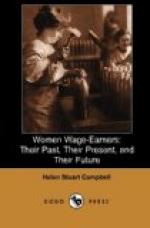Even at this stage England was determined that America should have neither machinery nor tools, and still held to the act passed in 1789 which enforced a penalty of five hundred pounds for any one who exported, or tried to export, “blocks, plates, engines, tools, or utensils used in or which are proper for the preparing or finishing of the calico, cotton, muslin, or linen printing manufacture, or any part thereof.”
Nothing could have more stimulated American invention; but there were many struggles before the thought finally came to all interested, that it might be possible to condense the whole operation with all its details under one roof,—a project soon carried out.
Thus far all had been tentative; but the building in 1790 at Pawtucket, R.I., of the first large factory with improved machinery gave the industry permanent place. Another mill was erected in the same State in 1795, and two more in Massachusetts in 1802 and 1803. In the three succeeding years ten more were built in Rhode Island and one in Connecticut, altogether fifteen in number, working about 8,000 spindles and producing in a year some 300,000 pounds of yarn. At the end of the year 1809 eighty-seven additional mills had been put up, making about 80,000 spindles in operation. Eight hundred spindles employed forty persons,—five men and thirty-five women and children.
The first authoritative record as to the progress of the manufacture, numbers employed, etc., was made in a report to the House of Representatives in the spring session of 1816. In the previous year 90,000 bales had been manufactured as against 1,000 in 1800. The capital invested was $40,000, and the relative number of males and females employed is also recorded,—
Males employed from the age of 17 and upward 10,000 Women and female children 66,000 Boys under 17 years of age 24,000
For these women spinning was the only work. Hand-looms still did all the weaving, nor was it possible to obtain any plan of the power looms,—then in use in England, and a recent invention. Another mill had been built in 1795; and thus the first definite and profitable occupation for women in this country dates back to the close of the eighteenth and the early years of the nineteenth century, the history of its phases having been written by Tench Coxe. The village tailoress had long gone from house to house, earning in the beginning but a shilling a day, and this sometimes paid in kind; and in towns a dressmaker or milliner was secure of a livelihood. But work for the many was unknown outside of household life; and thus wage rates vary with locality, and are in most cases inferential rather than matter of record.




